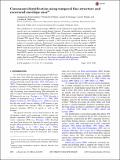| dc.contributor.author | Swaminathan, Jayaganesh | |
| dc.contributor.author | Reed, Charlotte M. | |
| dc.contributor.author | Desloge, Joseph G. | |
| dc.contributor.author | Braida, Louis D. | |
| dc.contributor.author | Delhorne, Lorraine A. | |
| dc.date.accessioned | 2015-11-10T19:35:15Z | |
| dc.date.available | 2015-11-10T19:35:15Z | |
| dc.date.issued | 2014-04 | |
| dc.date.submitted | 2014-01 | |
| dc.identifier.issn | 0001-4966 | |
| dc.identifier.uri | http://hdl.handle.net/1721.1/99897 | |
| dc.description.abstract | The contribution of recovered envelopes (RENVs) to the utilization of temporal-fine structure (TFS) speech cues was examined in normal-hearing listeners. Consonant identification experiments used speech stimuli processed to present TFS or RENV cues. Experiment 1 examined the effects of exposure and presentation order using 16-band TFS speech and 40-band RENV speech recovered from 16-band TFS speech. Prior exposure to TFS speech aided in the reception of RENV speech. Performance on the two conditions was similar (∼50%-correct) for experienced listeners as was the pattern of consonant confusions. Experiment 2 examined the effect of varying the number of RENV bands recovered from 16-band TFS speech. Mean identification scores decreased as the number of RENV bands decreased from 40 to 8 and were only slightly above chance levels for 16 and 8 bands. Experiment 3 examined the effect of varying the number of bands in the TFS speech from which 40-band RENV speech was constructed. Performance fell from 85%- to 31%-correct as the number of TFS bands increased from 1 to 32. Overall, these results suggest that the interpretation of previous studies that have used TFS speech may have been confounded with the presence of RENVs. | en_US |
| dc.description.sponsorship | National Institutes of Health (U.S.) (Grant R01 DC00117) | en_US |
| dc.description.sponsorship | National Institutes of Health (U.S.) (Grant R43 DC013006) | en_US |
| dc.language.iso | en_US | |
| dc.publisher | Acoustical Society of America (ASA) | en_US |
| dc.relation.isversionof | http://dx.doi.org/10.1121/1.4865920 | en_US |
| dc.rights | Article is made available in accordance with the publisher's policy and may be subject to US copyright law. Please refer to the publisher's site for terms of use. | en_US |
| dc.source | Acoustical Society of America | en_US |
| dc.title | Consonant identification using temporal fine structure and recovered envelope cues | en_US |
| dc.type | Article | en_US |
| dc.identifier.citation | Swaminathan, Jayaganesh, Charlotte M. Reed, Joseph G. Desloge, Louis D. Braida, and Lorraine A. Delhorne. “Consonant Identification Using Temporal Fine Structure and Recovered Envelope Cuesa).” J. Acoust. Soc. Am. 135, no. 4 (April 2014): 2078–2090. © 2014 Acoustical Society of America | en_US |
| dc.contributor.department | Massachusetts Institute of Technology. Department of Electrical Engineering and Computer Science | en_US |
| dc.contributor.department | Massachusetts Institute of Technology. Research Laboratory of Electronics | en_US |
| dc.contributor.mitauthor | Swaminathan, Jayaganesh | en_US |
| dc.contributor.mitauthor | Reed, Charlotte M. | en_US |
| dc.contributor.mitauthor | Desloge, Joseph G. | en_US |
| dc.contributor.mitauthor | Braida, Louis D. | en_US |
| dc.contributor.mitauthor | Delhorne, Lorraine A. | en_US |
| dc.relation.journal | The Journal of the Acoustical Society of America | en_US |
| dc.eprint.version | Final published version | en_US |
| dc.type.uri | http://purl.org/eprint/type/JournalArticle | en_US |
| eprint.status | http://purl.org/eprint/status/PeerReviewed | en_US |
| dspace.orderedauthors | Swaminathan, Jayaganesh; Reed, Charlotte M.; Desloge, Joseph G.; Braida, Louis D.; Delhorne, Lorraine A. | en_US |
| dc.identifier.orcid | https://orcid.org/0000-0003-1680-1913 | |
| dc.identifier.orcid | https://orcid.org/0000-0002-8431-4730 | |
| dc.identifier.orcid | https://orcid.org/0000-0003-2538-9991 | |
| dc.identifier.orcid | https://orcid.org/0000-0003-2673-3889 | |
| mit.license | PUBLISHER_POLICY | en_US |
| mit.metadata.status | Complete | |
